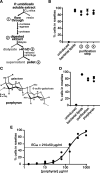This is a preprint.
A red algal polysaccharide influences the multicellular development of the choanoflagellate Salpingoeca rosetta
- PMID: 38798503
- PMCID: PMC11118467
- DOI: 10.1101/2024.05.14.594265
A red algal polysaccharide influences the multicellular development of the choanoflagellate Salpingoeca rosetta
Update in
-
A red algal polysaccharide influences the multicellular development of the choanoflagellate Salpingoeca rosetta.Curr Biol. 2025 Aug 4;35(15):3767-3776.e4. doi: 10.1016/j.cub.2025.06.059. Epub 2025 Jul 21. Curr Biol. 2025. PMID: 40695282
Abstract
We uncovered an interaction between a choanoflagellate and alga, in which porphyran, a polysaccharide produced by the red alga Porphyra umbilicalis, induces multicellular development in the choanoflagellate Salpingoeca rosetta. We first noticed this possible interaction when we tested the growth of S. rosetta in media that was steeped with P. umbilicalis as a nutritional source. Under those conditions, S. rosetta formed multicellular rosette colonies even in the absence of any bacterial species that can induce rosette development. In biochemical purifications, we identified porphyran, a extracellular polysaccharide produced by red algae, as the rosette inducing factor The response of S. rosetta to porphyran provides a biochemical insight for associations between choanoflagellates and algae that have been observed since the earliest descriptions of choanoflagellates. Moreover, this work provides complementary evidence to ecological and geochemical studies that show the profound impact algae have exerted on eukaryotes and their evolution, including a rise in algal productivity that coincided with the origin of animals, the closest living relatives of choanoflagellates.
Figures


Similar articles
-
A red algal polysaccharide influences the multicellular development of the choanoflagellate Salpingoeca rosetta.Curr Biol. 2025 Aug 4;35(15):3767-3776.e4. doi: 10.1016/j.cub.2025.06.059. Epub 2025 Jul 21. Curr Biol. 2025. PMID: 40695282
-
Cell differentiation controls iron assimilation in a choanoflagellate.bioRxiv [Preprint]. 2024 Sep 16:2024.05.25.595918. doi: 10.1101/2024.05.25.595918. bioRxiv. 2024. Update in: mSphere. 2025 Mar 25;10(3):e0091724. doi: 10.1128/msphere.00917-24. PMID: 39345370 Free PMC article. Updated. Preprint.
-
Sexual Harassment and Prevention Training.2024 Mar 29. In: StatPearls [Internet]. Treasure Island (FL): StatPearls Publishing; 2025 Jan–. 2024 Mar 29. In: StatPearls [Internet]. Treasure Island (FL): StatPearls Publishing; 2025 Jan–. PMID: 36508513 Free Books & Documents.
-
Signs and symptoms to determine if a patient presenting in primary care or hospital outpatient settings has COVID-19.Cochrane Database Syst Rev. 2022 May 20;5(5):CD013665. doi: 10.1002/14651858.CD013665.pub3. Cochrane Database Syst Rev. 2022. PMID: 35593186 Free PMC article.
-
The Black Book of Psychotropic Dosing and Monitoring.Psychopharmacol Bull. 2024 Jul 8;54(3):8-59. Psychopharmacol Bull. 2024. PMID: 38993656 Free PMC article. Review.
References
Publication types
Grants and funding
LinkOut - more resources
Full Text Sources
